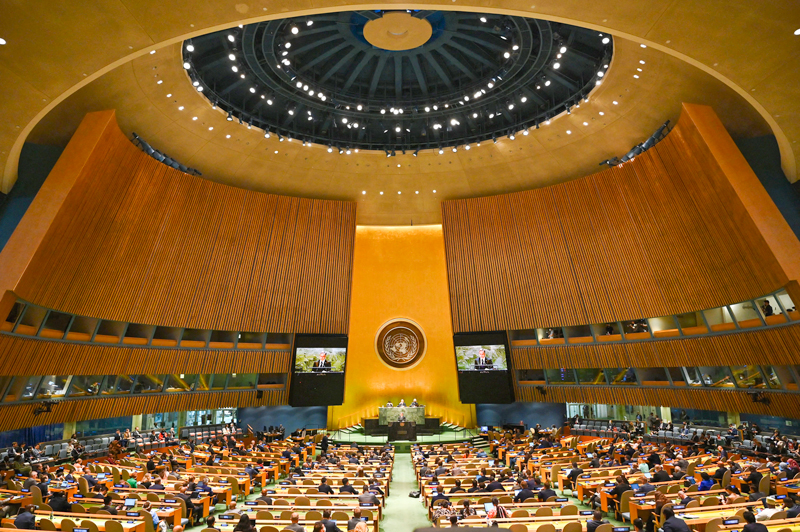
by Alexander Harang
Alexander Harang is the co-president of International Peace and Understanding, an organization that brings together various parties to strengthen public support and the political will needed to fundamentally change the role of nuclear weapons in security policy and prevent nuclear war.
The potential for nuclear confrontation (be it by design or accident) remains high due to the unfolding war in Ukraine, which tragically seems to be turning into a proxy war between Russia and the West and also has starkly revealed shifting power dynamics between the major nuclear powers—the U.S., Russia and China.
In War and Change in World Politics (1981), Robert Gilpin argues that such power shifts are inherently dangerous, as they: encourage opportunistic states to challenge the status quo; foster malicious perceptions of the others’ intentions; tempt declining powers to seek confrontation sooner rather than later; and make miscalculations more likely.
This war represents another step in the wrong direction, as there is a threat to use nuclear weapons not merely for traditional “deterrence” but as an offensive weapon. Technological uncertainties stemming from modernized arsenals (and countermeasures) translate into uncertainties as to when actual use of nuclear weapons is an option. This encourages proliferation as more midsize powers equate security with deterrence.
The foggier our security environment gets and the larger the number of potential adversaries, the less attention can be paid to the circumstances of each individual rival. This increases chances of catastrophic miscalculation. At a time when all principal actors think in terms of national interest, it is important to remember that the common interest of humanity is, no matter what, to halt the first strike.
In this situation, any viable path to nuclear disarmament needs to address the threshold of actual use of nuclear weapons. Declaring a No First Use policy is the obvious next step toward protecting humanity’s future against nuclear weapons.
It was in this context that the 191 state parties to the Non-Proliferation Treaty (NPT) met for its tenth review conference in New York in August. After three weeks of deliberations and negotiations, the conference wasn’t able to reach consensus on any final document.
This has been widely portrayed as a complete failure, for which Russia was largely blamed. This is not entirely correct. In fact, remarkable progress was made at this review conference, not on disarmament, but on risk reduction. The progress made on reducing the risk of actual use of nuclear weapons actually supersedes any previous conference of this sort.
SGI President Daisaku Ikeda’s emergency proposal to the NPT review conference lies at the heart of this remarkable progress. On July 26, Ikeda issued a statement to the NPT review conference calling for No First Use of nuclear weapons. At a time of historically high tensions globally and very little hope for multilateral disarmament, Ikeda’s statement contributed to redirecting focus toward what can actually be done to avoid nuclear war. It instilled hope for the ultimate abolition of all nuclear weapons.
In this emergency proposal, Ikeda urges the U.N. conference to include the following three elements in its final document: first, that the five nuclear-weapon states (U.S., Russia, China, U.K. and France) immediately pursue measures to reduce the risks posed by nuclear weapons in accord with their nuclear disarmament commitments as defined by NPT Article VI; second, that the five nuclear-weapon states, as a matter of highest priority, declare their commitment to the principle of No First Use at the earliest possible date; and third, that the principle of No First Use be universalized as the security policy of all states possessing nuclear weapons as well as the nuclear-dependent states.
This provided the conference with constructive proposals on how to cool down the overheated security environment, which in turn helped states engage in constructive dialogue. Hence, we saw an optimism not anticipated in the first week of the conference. It became clear that the vast majority of states understood the immediate risk of nuclear war as far too high and that declaring No First Use may be the most effective answer to this immediate problem.
Resulting from this unexpected optimism, No First Use language was adopted in an NPT draft document for the first time in the treaty’s five-decades-long history. The draft of Aug. 12 reads as follows: “The nuclear-weapon States and their allies agree to take steps to reduce and eliminate the role of nuclear weapons in national and collective security doctrines; for nuclear-weapon States this should include the adoption of No First Use or sole purpose doctrines.”
As anyone can see, this is what Ikeda called for in his emergency proposal. This agreement on No First Use language was developed further in the drafts on Aug. 17 and 22. This agreement on No First Use held all the way until the second to the last day of the conference, when the nuclear weapons states insisted that the reference to them adopting No First Use policies had to be dropped.
By this time, the conference climate had gone sour, mainly over disagreements in regard to the war in Ukraine. This made it impossible to reach consensus on a final document on Aug. 26, the last day of the review conference.
It is now of crucial importance that we do not forget the progress made on No First Use during the NPT review conference. As Russia continues to threaten to use nuclear weapons, we should all remember the agreement reached on No First Use at the NPT review. Even Russia was part of this initially, which indicates an agreement on this crucial issue is possible.
Facing the immediate risk of nuclear war, we cannot throw the No First Use “baby” out with the NPT “bathwater.” For the sake of humanity, we should therefore continue to promote No First Use policies for all nuclear-armed states, following the guidance given on this matter by Ikeda’s statement of July 26.
Eliminating Nuclear Weapons
To learn more about abolishing nuclear weapons, check out Soka Gakkai’s “Transforming Human History” campaign, accessible at www.sokaglobal.org/campaigns/transforming-human-history/.
You are reading {{ meterCount }} of {{ meterMax }} free premium articles

